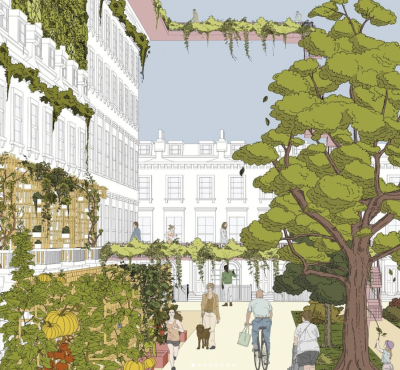These two creative and reflective Master's degrees consider interventions in the landscape through imaginative design, strategic thinking and technical knowledge.
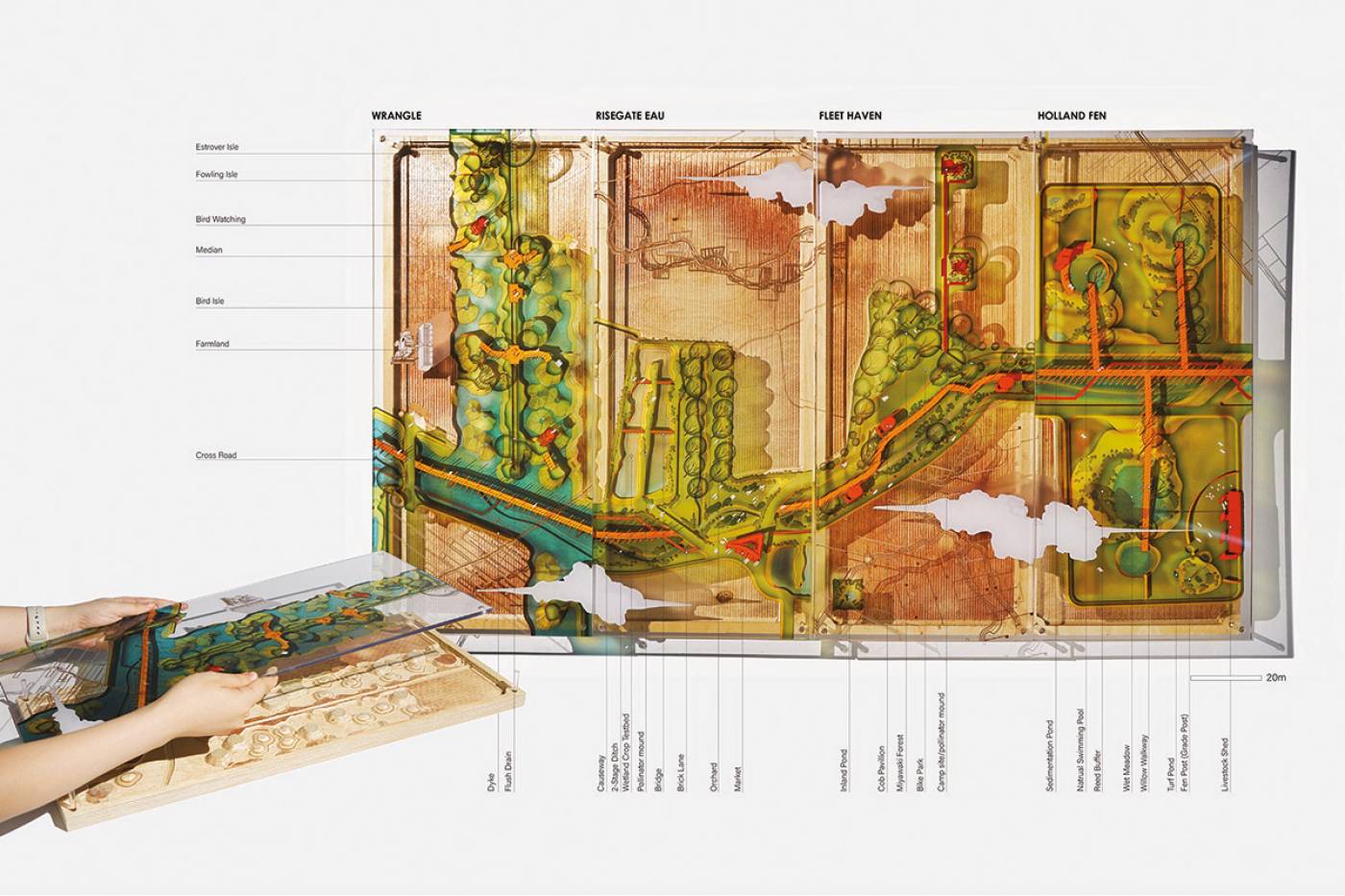
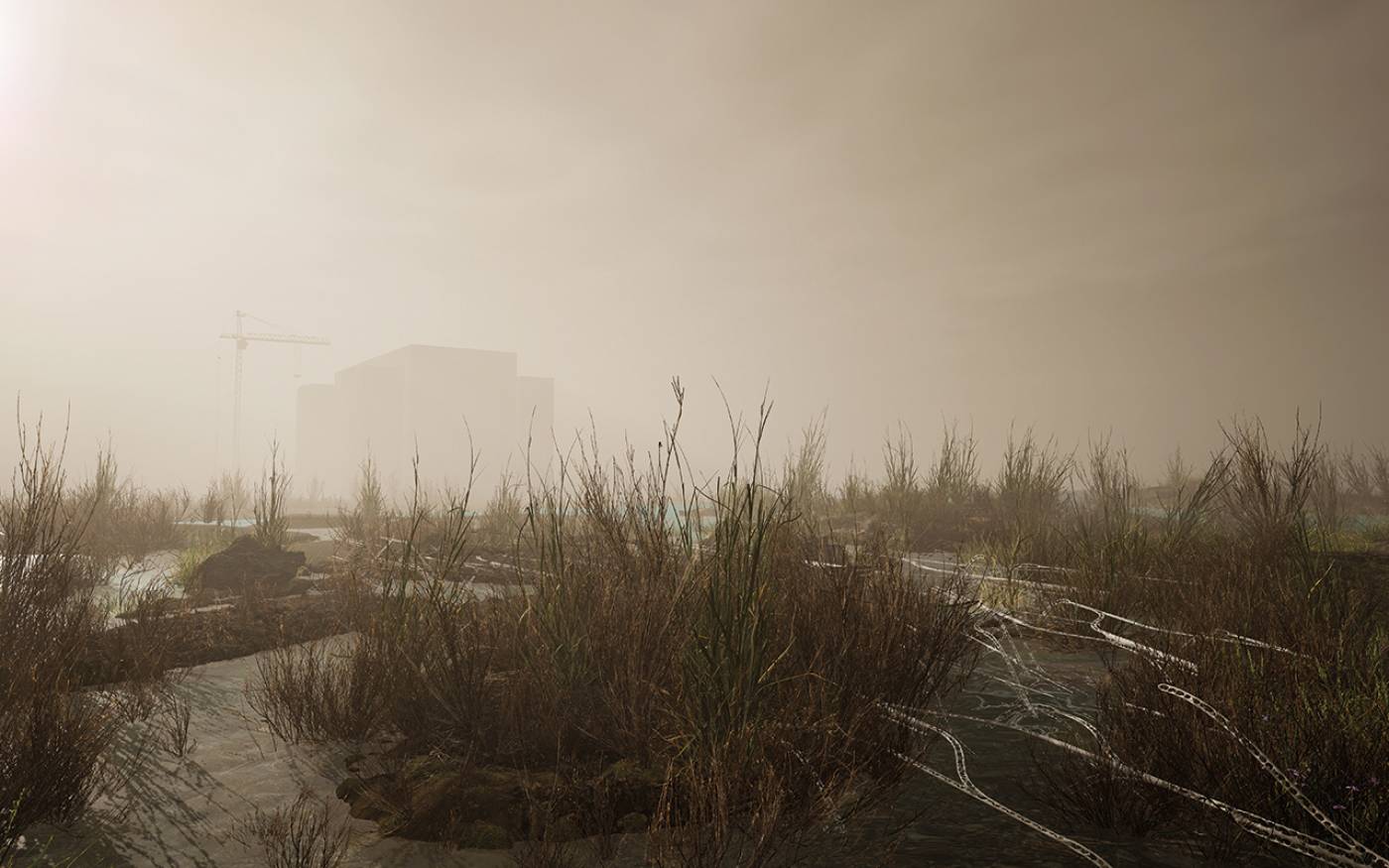
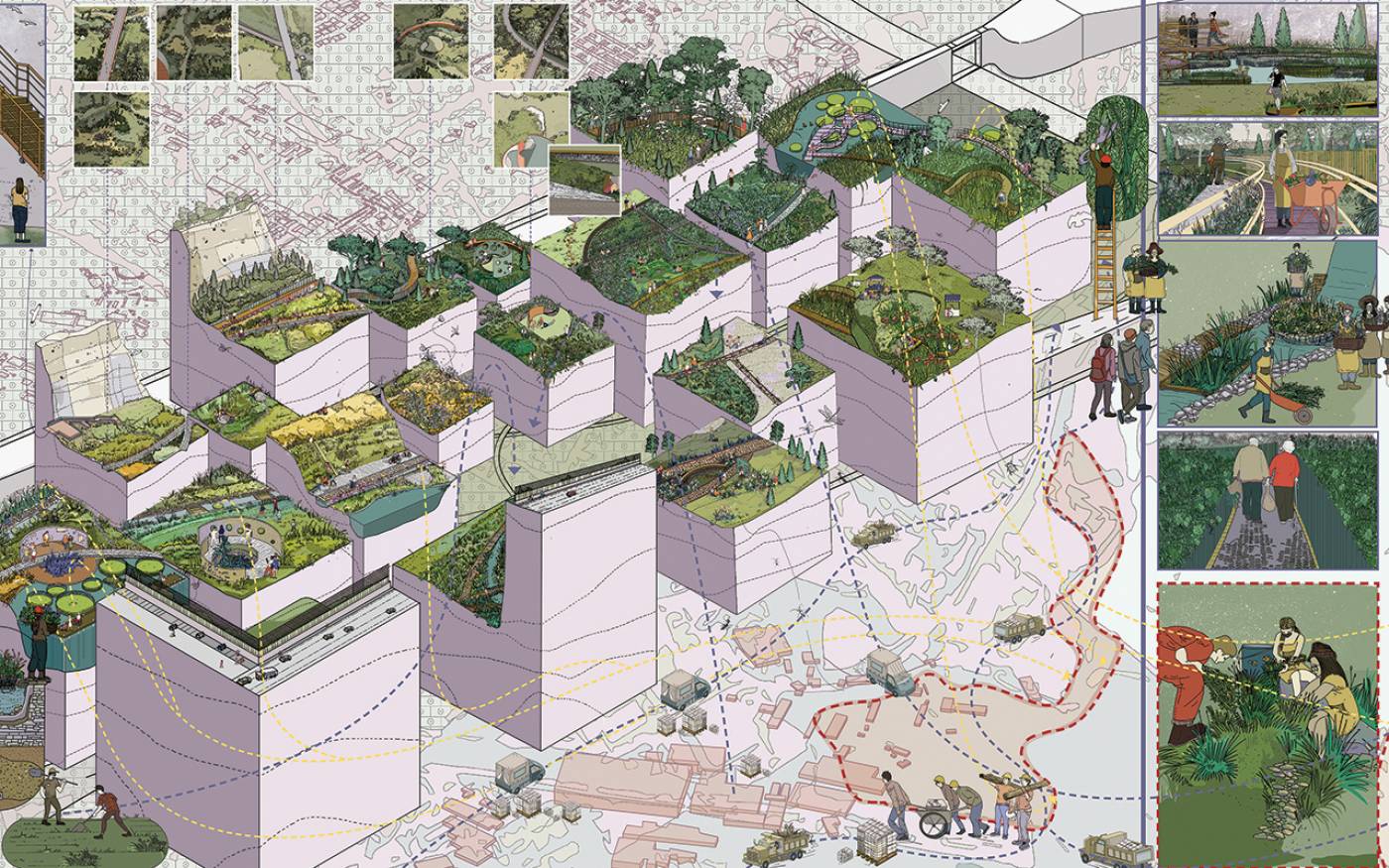
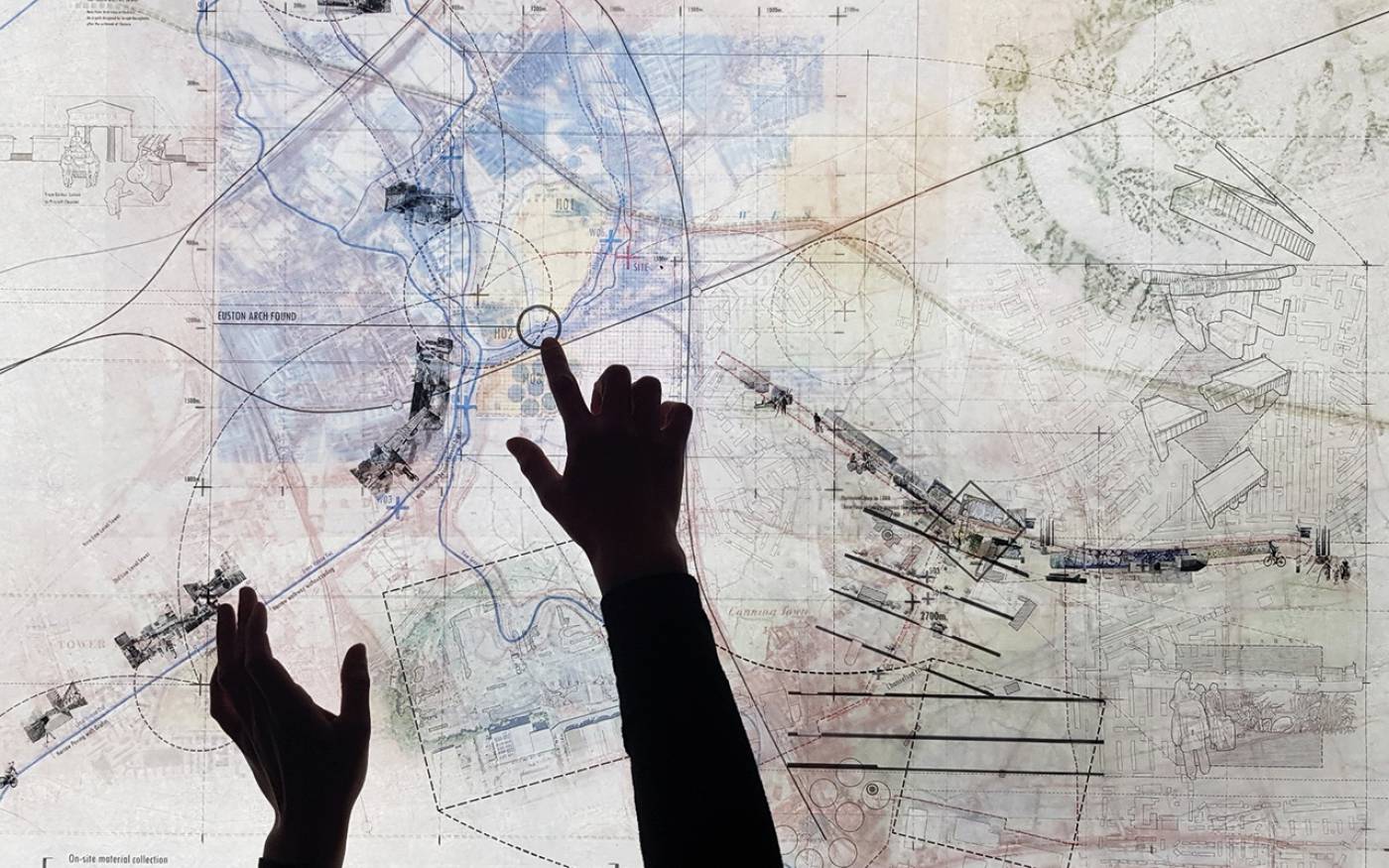
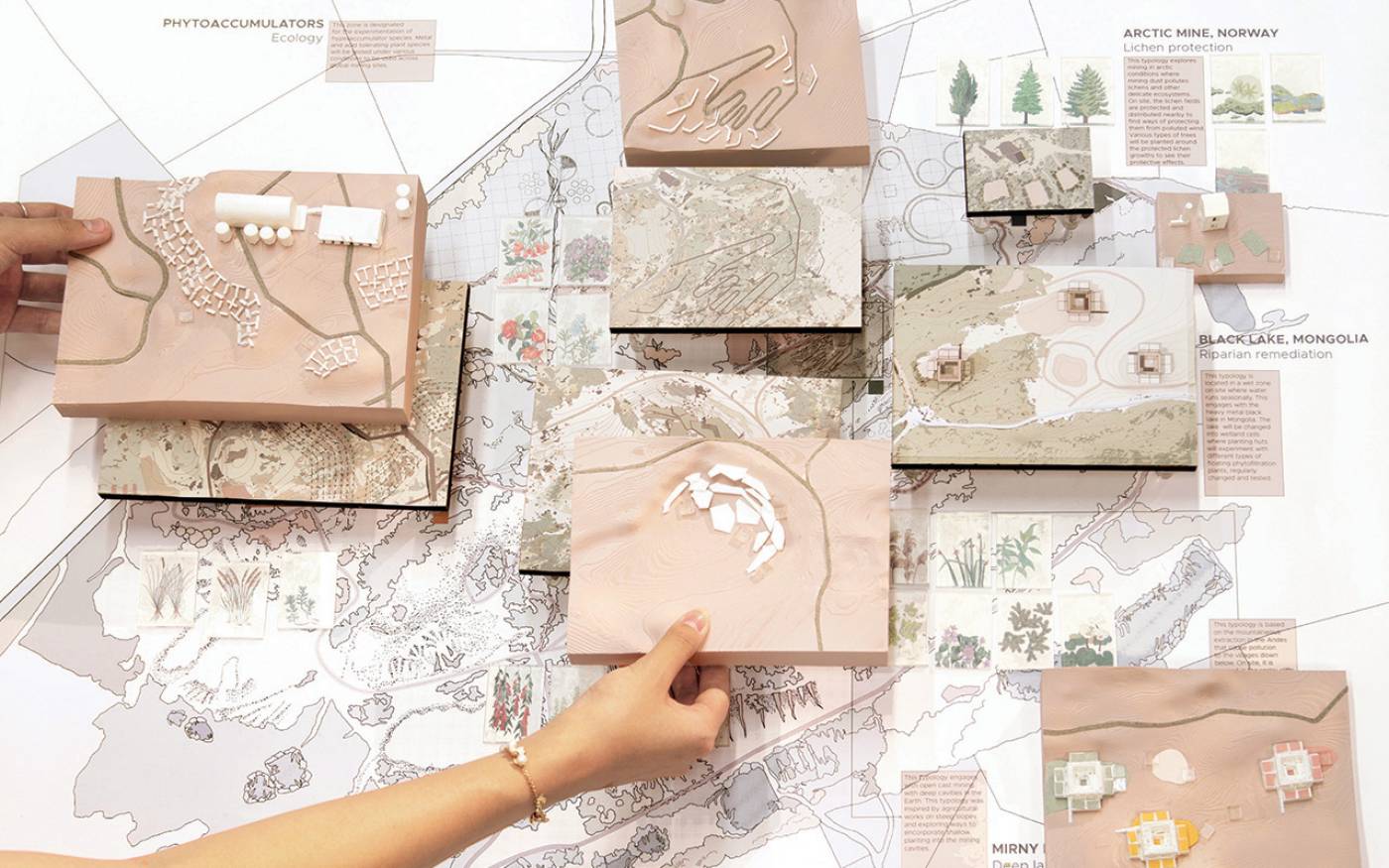
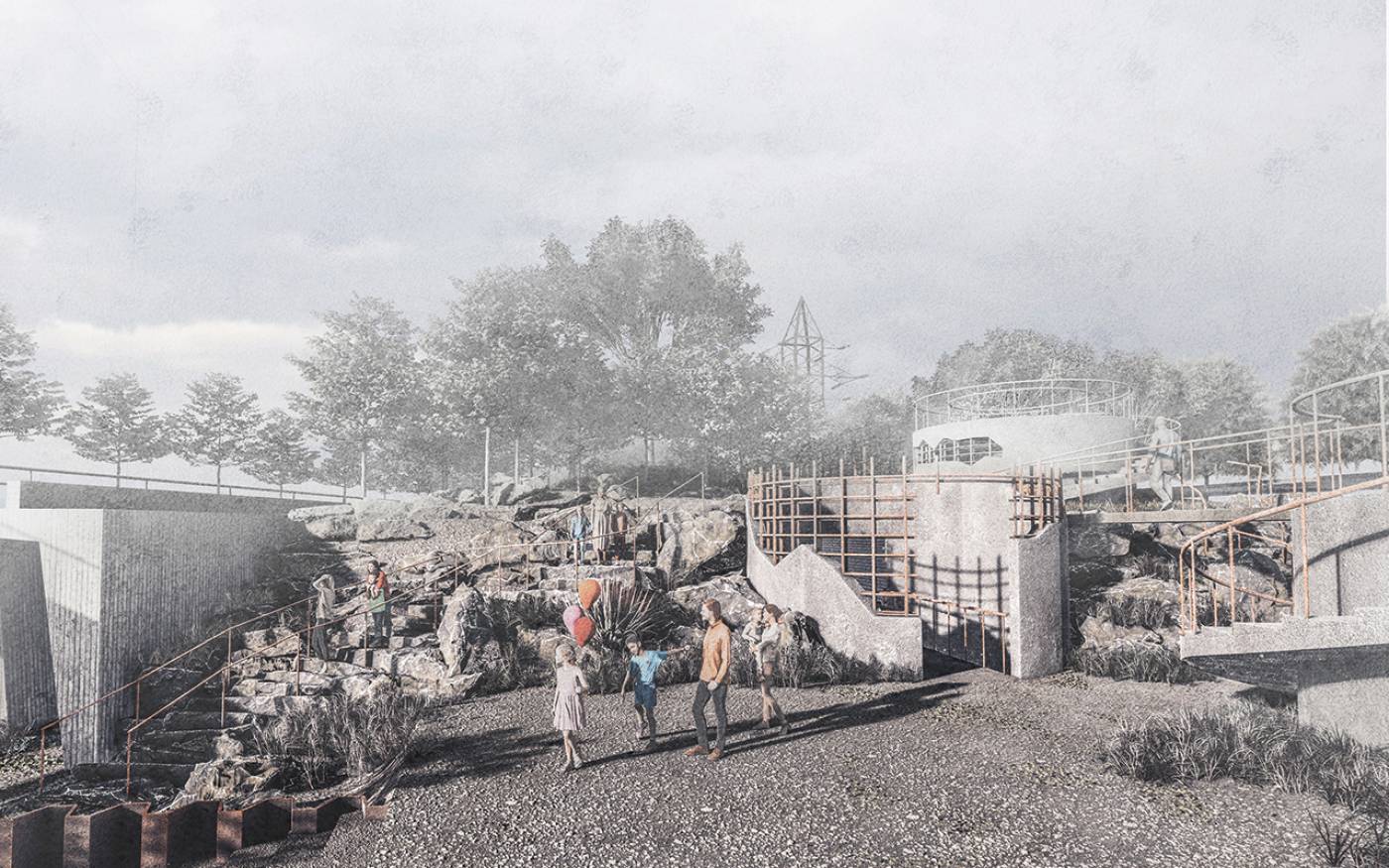
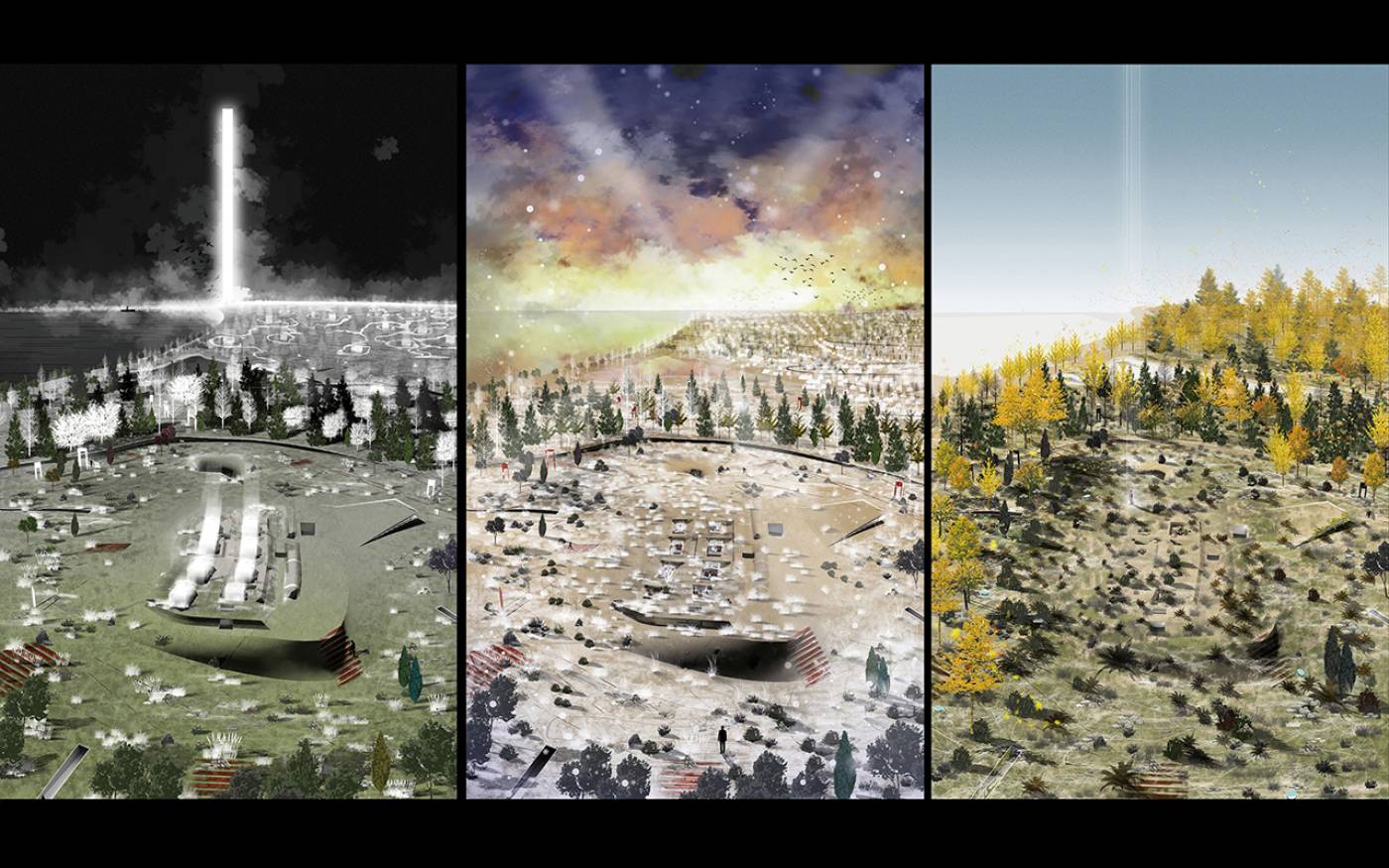
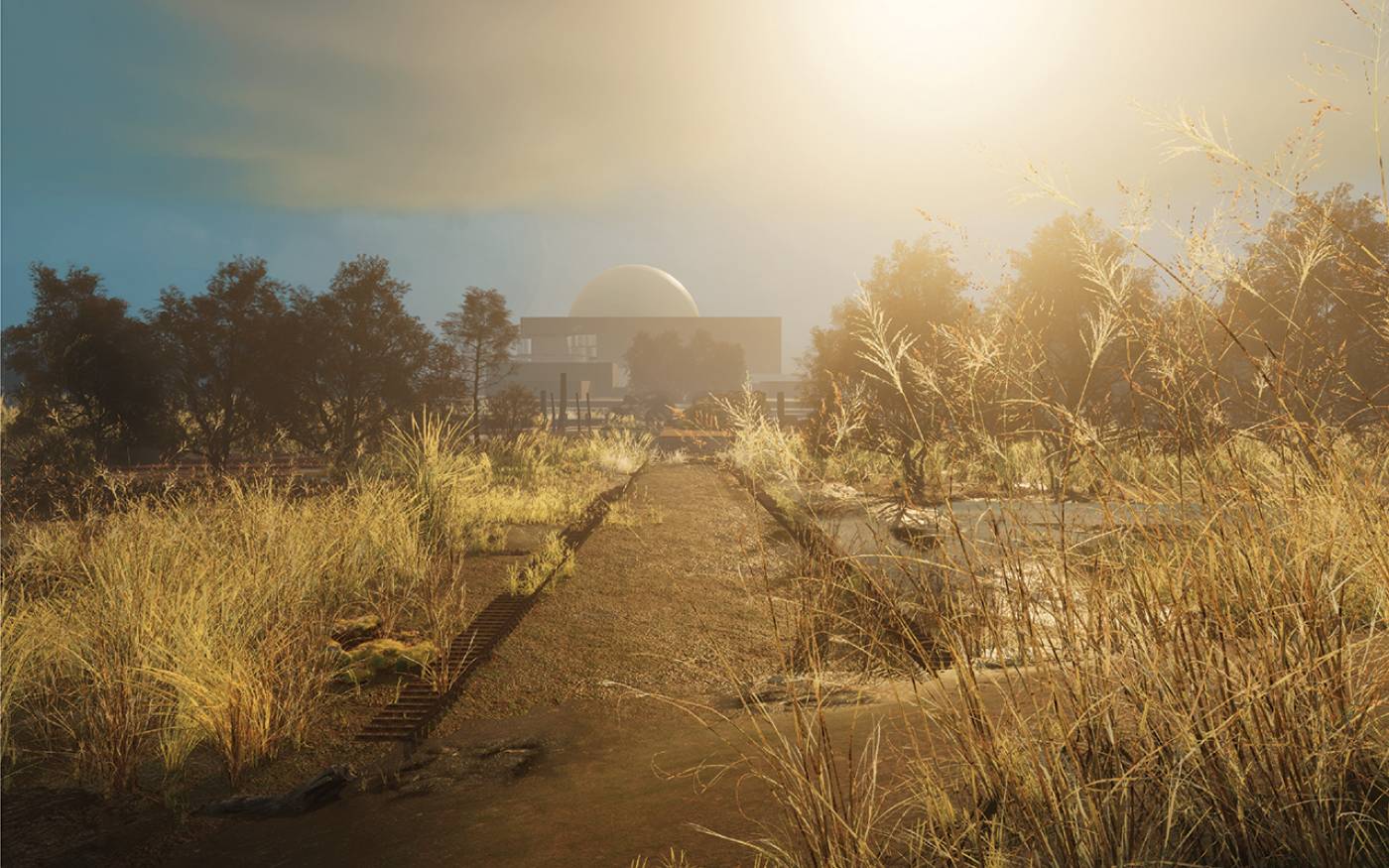
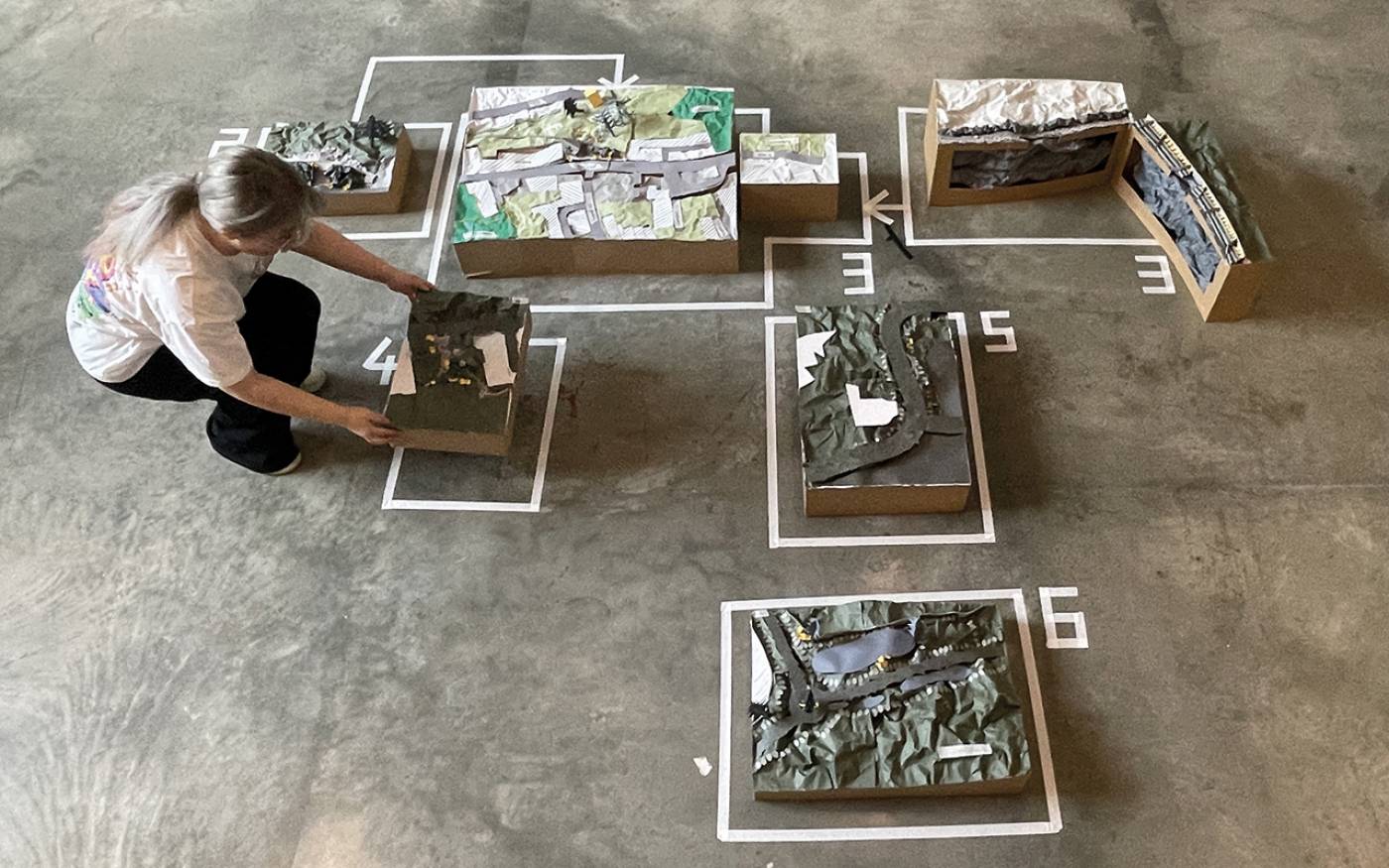
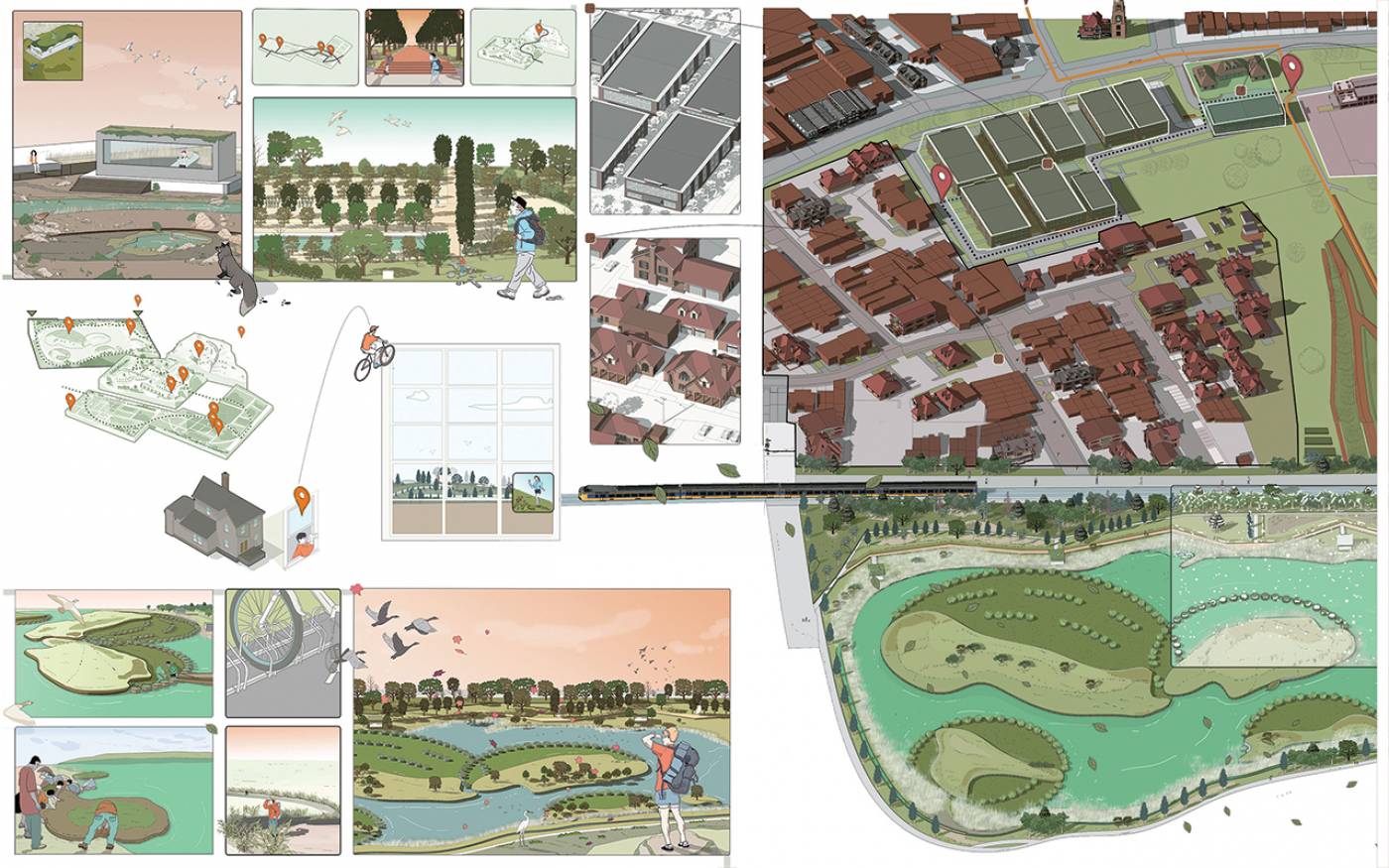

Register for Landscape Architecture In-Person Open Evening on 22 May 2024
About
With design-led teaching and learning, these two accredited Master's programmes allow students to progress towards a career as a landscape architect. Students work to put their theories into practice from week one, researching through speculative design.
Both programmes are committed to an agenda of climate-focused landscape design and environmental stewardship, preparing students to address sustainability and deal with real-world challenges, such as biodiversity loss, climate change and ecological crisis. The core priority of the Landscape Architecture programmes is to equip students with the skills and knowledge needed to innovatively respond to ecological, urban and social challenges through their work with natural and built environments.
In both programmes, Design Studios form a core component, giving students the opportunity to work independently or in groups to develop their own approach to landscape architecture. Within the Design Studios, tutors present unique, rigorous, challenging and even radical intellectual positions, providing a strong identity for students to use as the basis for developing their own approach to the contemporary study of landscape architecture.
Students refine their communication skills through seminar presentations, written work, design reviews and exhibitions. A series of workshops and classes are available to help students gain integral skills, from planting and horticulture to VR and mixed reality modelling.
Landscape architecture design teaching, for both MLA and MA students, is complemented with history and theory lectures, seminars and readings, examining the interdependence of thought, action and form in history, society, culture and geography.
- Find out more about Landscape Architecture MA/MLA's Design Studios
- Find out more about studying Landscape Architecture, on our Instagram
- Explore student projects via The Bartlett Autumn Show
- View our virtual open day recording
Landscape architecture is available to study in two degrees at The Bartlett, taught over either one or two years:
- Our Landscape Architecture MLA is taught full-time over two years, acting as a conversion programme for students without a landscape architecture undergraduate degree;
- Whereas, our Landscape Architecture MA is taught full-time over one year, for students who already have a UK landscape architecture undergraduate degree, or an overseas qualification of an equivalent standard.
Highlights
- Work with a team of landscape architects, researchers and built environment professionals to inform your creative design practice
- Gain innovative design research skills, interdisciplinary knowledge and critical thinking necessary to address real-world environmental, urban and social challenges, today and in the future
- Develop a detailed knowledge and understanding of the potential of the landscape architecture profession
- Learn in The Bartlett’s unique studio culture, enjoying interdisciplinary opportunities across the faculty and UCL
Landscape Architecture MLA
This is a two-year Master's degree which empowers students without a landscape architecture undergraduate degree or background to pursue a career as a landscape architect.
The first year is a preparatory year, as students entering the programme will typically be new to the discipline of landscape architecture. The second year has a strong design research focus, with a major design studio project and research project complementing each other and giving students the platform to develop highly developed portfolios upon graduation.
Modules
Year 1
- History and Theory of Landscape Architecture (30 credits)
A wide-reaching module that introduces and locates the discipline and addresses the history of landscape architecture practice and its evolution in the UK and internationally. Site visits to a range of seminal projects encourage students to think reflectively and critically about the nature of these projects and their historical and geographical contexts.
- Landscape, Inhabitation and Environmental Systems (30 credits)
This module sets out the discipline of landscape architecture in relation to physical and natural processes and anthropogenic impacts, looking at its relationship to resource systems, ecology and climates, hydrology and geology and topography.
Students explore case studies to examine key aspects of landscape appraisal and environmental assessment, planning and design strategy, and the integration of these matters into coherent landscape architecture projects. Landscape architecture detail is addressed, relating seasonality to materials, horticulture, soft and hard landscaping.
- Landscape Design 1 (15 credits)
The first of three Design Studio-based modules providing students with an introduction into: landscape and site appraisal via site visits; processes of making and forming natural and constructed landscapes via introductory lectures and design projects; techniques of landscape representation and design processes.
- Landscape Design 2 (15 credits)
This design studio module builds on the work undertaken in Landscape Design 1, developing use of precedent studies, landscape appraisals and evaluations for a specific site.
- Landscape Design 3 (30 credits)
This third and major design module builds on the work undertaken in Landscape Design 1 & 2, particularly studies of site and the aims, ambitions and processes of design strategies. Students envisage and develop a landscape design for a specific site using multiple design scales, drawing and modelling it in ways appropriate to the chosen proposal. The module explores many landscape architecture dimensions in depth to reach high-level design inspiration, strategic thinking and technical resolution.
Year 2
- Landscape Architecture Practice and Theory (15 credits)
This module undertakes a critical review of contemporary landscape architecture and the ideas and interests that underlie it. It locates the discipline of landscape architecture within the broader professional realm, both in the UK and internationally. Conventional and innovative modes of practice are explored and students develop critical work on the status of landscape architectural practice and the profession, with reference to selected case study organisations and projects.
- Landscape, Ecology and Urban Environments (30 credits)
This module addresses the role that landscape architecture can play in synthesis of urban environments to help tune and fundamentally change the nature of the ‘urban metabolism’. Innovative historical and current case studies are interrogated in detail to reveal key aspects of their urban landscape context, design strategies and implementation.
- Landscape Thesis (45 credits)
Following initial workshop sessions on research methods and research methods submission, students write a thesis on an area of particular area of interest to them within the field. each student's thesis is expected to use critical reasoning skills to create an argument, supported by graphic evidence and appropriate research.
- Advanced Landscape Design 1 (30 credits)
This is a preparatory module that establishes a site context and areas of interest that each student intends to advance further in the Landscape Design Thesis module. A range of Design Studios are offered to students, each of which has its own pedagogical stance with regard to landscape design and formulates a project brief within the aims and outcomes of the module including:
- Landscape appraisal
- Processes of making and forming natural and constructed landscapes
- Development of aims and ambitions, intentions and targets, and design strategies
- Detailed design proposals
- Techniques of landscape representation
- Advanced Landscape Design 2 (60 credits)
In this module, students use their previous studies and knowledge from field trips to develop a project for a site. They address areas of interest and undertake appropriate research whilst developing a complex, contextual landscape design to a level appropriate to a graduating masters project. Students are expected to demonstrate an advanced level of skill and expertise, further developing selected areas of knowledge particular to the individual brief and site.
Landscape Architecture MA
This is a one-year Master's degree for students looking to pursue a career in landscape architecture who already have UK Landscape Architecture degree, or overseas equivalent.
Landscape Architecture MA has a strong design research focus, with a major design studio project and research project complementing each other and giving students the platform to develop impressive portfolios upon graduation.
Modules
- Landscape Architecture Practice and Theory (15 credits)
This module undertakes a critical review of contemporary landscape architecture and the ideas and interests that underlie it. It locates the discipline of landscape architecture within the broader professional realm, both in the UK and internationally. Conventional and innovative modes of practice are explored and students develop critical work on the status of landscape architectural practice and the profession, with reference to selected case study organisations and projects.
- Landscape, Ecology and Urban Environments (30 credits)
This module addresses the role that landscape architecture can play in synthesis of urban environments to help tune and fundamentally change the nature of the ‘urban metabolism’. Innovative historical and current case studies are interrogated in detail to reveal key aspects of their urban landscape context, design strategies and implementation.
- Landscape Thesis (45 credits)
Following initial workshop sessions on research methods and research methods submission, students write a thesis on an area of particular area of interest to them within the field. each student's thesis is expected to use critical reasoning skills to create an argument, supported by graphic evidence and appropriate research.
- Advanced Landscape Design 1 (30 credits)
This is a preparatory module that establishes a site context and areas of interest that each student intends to advance further in the Landscape Design Thesis module. A range of Design Studios are offered to students, each of which has its own pedagogical stance with regard to landscape design and formulates a project brief within the aims and outcomes of the module including:
- Landscape appraisal
- Processes of making and forming natural and constructed landscapes
- Development of aims and ambitions, intentions and targets, and design strategies
- Detailed design proposals
- Techniques of landscape representation
- Advanced Landscape Design 2 (60 credits)
In this module, students use their previous studies and knowledge from field trips to develop a project for a site. They address areas of interest and undertake appropriate research whilst developing a complex, contextual landscape design to a level appropriate to a graduating masters project. Students are expected to demonstrate an advanced level of skill and expertise, further developing selected areas of knowledge particular to the individual brief and site.
Key information
Modes/duration
MLA
Full-time, two years
MA
Full-time, one year
Entry requirements
MLA
Eligibility Requirements:
- A minimum of a second-class UK degree in an appropriate subject or an overseas qualification of an equivalent standard.
Applicants with no prior degree in Landscape Architecture should apply for the MLA programme. We welcome applicants from a variety of design-related or relevant backgrounds, including Architecture and Environmental Design.
A design/creative portfolio is also expected. The portfolio is used to assess applicants’ aptitude for visual and creative thinking and design, and to gauge previous relevant experience. Applicants will be asked to provide a link to an online portfolio of their design work once their completed application has been received and should not send or upload work until it has been requested by the department.
- Read the full entry requirements for Landscape Architecture MLA on the UCL Graduate Prospectus
- Read the full porfolio guidance for Landscape Architecture MLA
MA
Eligibility Requirements:
- A minimum of a second-class UK degree in landscape architecture or an accredited overseas qualification in landscape architecture of an equivalent standard. On occasion, graduates from other degrees who can demonstrate comparable abilities will also be considered.
- A minimum of one year (completed or in progress) in a professional practice placement or internship.
Students who have not yet graduated must apply for the MLA programme (see above).
A design/creative portfolio is also expected. The portfolio is used to assess applicants’ aptitude for visual and creative thinking and design, and to gauge previous relevant experience, both academic and practice based. Applicants will be asked to provide a link to an online portfolio of their design work once their completed application has been received and should not send or upload work until it has been requested by the department.
- Read the full entry requirements for Landscape Architecture MA on the UCL Graduate Prospectus
- Read the full porfolio guidance for Landscape Architecture MA
Application guidance for 2024 entry
Applicants can only apply for a maximum of two postgraduate degree programmes at The Bartlett School of Architecture.
Application deadline
Applications for 2024 entry open on 16 October 2023 and close on 5 April 2024 (for applicants requiring a visa) and 30 August 2024 (for applicants not requiring a visa). We strongly advise early application, as our programmes are over subscribed and competition is high.
Deferral
It is not possible to defer an offer at The Bartlett School of Architecture. If you wish to be considered for the following year then you must reapply in the next admissions cycle.
Tier 4 Student visa holders
Tier 4 Student visa holders are required to meet the English language proficiency of their offer with sufficient time to obtain a CAS number and visa.
Accepting your offer
To accept your offer, you must pay the non-refundable fee deposit and decline any other offers for programmes at The Bartlett School of Architecture. If you do not respond within the given time indicated on your UCL offer letter, then your offer will be withdrawn.
Fees and funding
- Tuition fee information can be found on the UCL Graduate Prospectus entries for Landscape Architecture MA and Landscape Architecture MLA.
- For a comprehensive list of the funding opportunities available at UCL, including funding relevant to your nationality, please visit the Scholarships and Funding section of the UCL website.
Staff
- Laura Allen and Mark Smout, Programme Directors
Laura Allen, Professor of Architecture and Augmented Landscapes and Mark Smout, Professor of Architecture and Landscape Futures – known collectively as Smout Allen – co-direct the Landscape Architecture programmes and teach Architecture MArch, Unit PG11 at The Bartlett.
Smout Allen teach, lecture and exhibit internationally, with recent venues including the Architectural Association, the RIBA, SCI-Arc Los Angeles and the Nevada Museum of Art. They have been selected for both the Venice Biennale and the inaugural Chicago Biennial. ln 2012 they won a commission from the Mayor of London and the Olympic Delivery Authority for the design of the ‘Universal Tea Machine’ —a giant, tea-making, binary adding calculator.
Smout Allen’s most recent projects ‘Infractus: The Taking of Robin Hood Gardens’, ‘L.A.T.B.D’ (in collaboration with Geoff Manaugh) and ‘Liquid Kingdom’ investigate near and distant future scenarios for cities and landscapes, public engagement, science facts and fictions, art and the environment, agriculture, cartography, model making, model villages and games.
- Visit Smout Allen's website
- Follow Smout Allen on Instagram and Twitter
- Henrietta Williams, Departmental Tutor
Henrietta Williams is an artist and urban researcher. Her practice explores urbanist theories; particularly considering ideas around fortress urbanism, security, and surveillance. She is a Lecturer (teaching) at The Bartlett School of Architecture, UCL, and tutors across a number of programs with a particular focus on critical film making methodologies. Her projects have been widely screened, exhibited and published in the UK and internationally, most notably at the V&A Museum in London and on the front page of the Guardian.
Henri is currently working towards an LAHP funded PhD by design The Bartlett that critiques drone surveillance technologies and the history of the aerial viewpoint. She established and curates The Bartlett Screening Room, a digital forum to screen short films and artist moving image works.
- Aisling O'Carroll, Landscape Architecture MLA Year 1 Coordinator
Aisling O'Carroll is a landscape architect, trained in both architecture and landscape architecture. Her research and design practice addresses the relations between history, narrative, and representation in architecture, landscape, geology, and hybrids of the three—examining, in particular, critical approaches to reconstruction as design. She is currently completing her PhD by design at The Bartlett, funded by UCL’s Graduate Research Scholarship.
Aisling has taught graduate design studios in architecture, urbanism, and landscape architecture at The Bartlett, Harvard Graduate School of Design, and the University of Toronto. She has practiced internationally for several years with design firms and research platforms, including Michael Van Valkenburgh Associates,and P-Rex Lab at MIT. She is co-founder and co-editor in chief of The Site Magazine.
- Diana Salazar, Landscape Architecture MLA Year 2 / MA Coordinator
Diana Salazar holds a Bachelor’s degree in Ecology from Javeriana University in Colombia and an MSc in Environment and Sustainable Development from the Development Planning Unit at UCL. She has 15 years of experience in sustainability and environmental justice in education, cross-disciplinary research and managing projects in the UK and internationally. She has written about the political ecology of seed cultivation in Colombia and the Energy Landscape in Maputo, Mozambique. Her current research links postcolonial theory with political ecology, history, extractivism and activism. She is conducting a PhD in Architectural History and Theory at the Bartlett, funded by the UBEL DTP – ESRC. Diana is a Trustee of London Mining Network.
Diana has taught history and theory of architecture at The Bartlett, Central Saint Martins - University of the Arts London, and Greenwich University. She has also taught in UCL’s Development Planning Unit and the Department of Geography.
- Tim Waterman, Landscape History and Theory and Landscape Thesis Module Coordinator
Tim Waterman, Senior Lecturer in Landscape Architecture History and Theory, is a landscape architect and theorist whose research explores the interconnections between food, taste, place, and democratic civil society. He also writes about landscape imaginaries from the perspective of utopian studies, and is deeply involved in the ongoing discourse in the emerging subjects of landscape justice, landscape democracy, and landscape citizenships.
Tim is the Vice President of the European Council of Landscape Architecture Schools (ECLAS) and a Non-Executive Director of the digital arts collective Furtherfield.
Tim is the author of Fundamentals of Landscape Architecture, now in its second edition and translated into several languages, and, with Ed Wall, Basics Landscape Architecture: Urban Design. He has co-edited two recent volumes from Routledge: Landscape and Agency: Critical Essays, with Ed Wall, and the Routledge Handbook of Landscape and Food, with Joshua Zeunert.
- Tom Keeley, Co-Coordinator History and Theory
Tom Keeley is an artist-historian working within architectural design. His topographic practice works between architectures, geographies, and landscapes, using artistic practices to write and rethink architectural and landscape histories. This research-led practice generates site-specific outputs ranging from writing, printed matter and photography, to film, installation and performance.
His work was shortlisted to represent Ireland at the 2023 Venice Architecture Biennale, and has been exhibited internationally including at the Biennale, the Salone del Mobile Milano, and the Istanbul Design Biennial, and is held in the collections of the National Art Library at the V&A and the School of Architecture Library at Princeton University. His writing has been published in publications including Places Journal, The Architectural Review, Building Material, MacGuffin, and Domus.
Tom trained in landscape architecture at the University of Sheffield and architectural history at the Bartlett, where he is currently completing an AHRC-funded PhD in architectural design studying the architectures and landscapes of the Irish borderlands. Previously he worked for The Architecture Foundation (London, UK), Storefront for Art and Architecture (New York, USA), and Space Caviar (Genoa, Italy).
- Ana Abram, Landscape Inhabitation and Environmental Systems and Landscape, Ecology and Urban Environments Modules Coordinator
Ana Abram is a licensed landscape architect and urbanist, whose work bridges academia, research and practice. Ana’s research addresses the relationships between dynamic landscape systems, urbanism, and ecological contexts through design syntheses, while engaging with multi-scale processes, from anthropogenic territorial to human scale interventions.
Ana is a co-founder of the practice Amphibious Lab, which focuses on dynamic landscapes and their interfaces with anthropogenic environments. Ana has led design and research teams, winning design concepts at numerous international competitions while working with notable landscape architecture practices, including Gustafson Porter + Bowman and Turenscape.
Ana has experience in delivering projects through all stages, from concept to completion, including the prestigious Chelsea Barracks masterplan, and the post-Olympic development International Quarter London.
- Maj Plemenitas, Skills Workshops and Classes Coordinator
Maj Plemenitas is an inventor, researcher and academic. His past and current appointments include the Co-Directorship of the Landscape Architecture MA/MLA programmes at UCL Bartlett School of Architecture, the founding and directorship of the AMPHIBIOUS Lab and the research practice LINKSCALE. He is focused on cross-scale design and multi-scale spatial, temporal and operations strategies, systems and structures in architectural, urban and landscape contexts. For his original contribution to research, innovation and design, Maj received a range of internationally acclaimed design awards and research grants, including the Holcim Foundation Prize. Maj lectures internationally. He also exhibits globally in venues including the Royal Academy of Arts, Venice Biennale, and Roca Gallery. Maj has published on the role of CSD cross-scale design, computation, Growing Islands and resilient shorelines, Amphibious Interfaces and Multi-Scale Flow Maps, and autonomous territorial production strategies.
- Emma Colthurst, Admissions Tutor
Emma Colthurst is an interdisciplinary designer and researcher, trained in both architecture and landscape architecture. Her research and design practice explores the interconnections between material movements, ecological perspectives, and urban equity - examining critical approaches to multi-sited and multispecies anthropology. She is currently completing her PhD at the University of Greenwich, funded by a VC Scholarship.
Emma has taught graduate design studios in landscape architecture and urbanism at The Bartlett and the University of Greenwich. She has practised with design firms and research platforms, and taught, exhibited, and lectured on landscape architecture. Her design and research projects are featured in a variety of publications and press, including Architectural Design (AD) and Landscape Architecture Australia.
Accreditation
These programmes are professionally accredited by the Landscape Institute (LI). Find out more about the Landscape Institute.

Careers
The Bartlett School of Architecture is one of the world's top-ranked architecture schools and our graduates enjoy excellent employment opportunities.
Contacts
Programme Directors: Laura Allen and Mark Smout
Admissions Tutor: Emma Colthurst
Programme admissions enquiries: Complete the contact form
Programme Administrator: Zoe Lau
Design Studios
Both Landscape Architecture MA and Landscape Architecture MLA are taught partly through Design Studios. Seven Studios are currently running in the 2023-24 academic year. Please find briefs for each Studio below.
- Studio 1
- Feral Landscapes
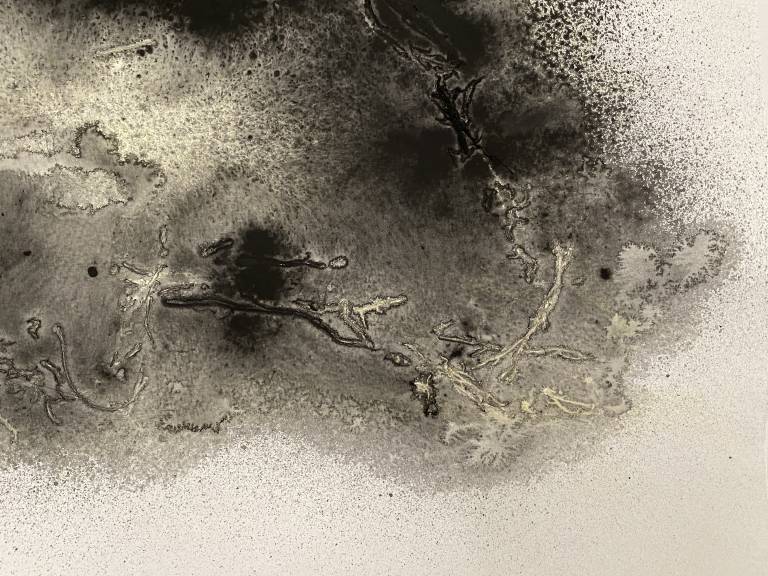
Eric Guibert and Emma Colthurst
Studio 1 investigate regenerative ways of creating landscapes that value what is already present and co-create with these living beings and systems. Philosophically, this Studio recognise that humans are not at the centre, but rather share the world with all beings equally. According to Isabelle Stengers, "Taking a 'modern animist' position, we will work with the agency of other-than-humans". Understanding the mutual interdependence requires new systems of thinking-with and making-with. Studio 1 will follow three key lines of enquiry:
- Speculate on the possible ecological politics embodied in the proposed landscape practices, aiming for climate and biodiversity justice that balance the needs of all living beings and communities, human or otherwise.
Interrogate which economies and modes of ownership can sustain biodiverse and resilient landscapes.
Focus closely on the modes of care and other making practices that embody this position.
Their speculations will aim to answer four questions:
- How can landscapes be co-created with other-than-human species and systems?
- How can equal voice be given to various human and other-than-human communities?
- What does it mean to hold open space in the world for other-than-human beings, and what relations are at stake?
- What kind of aesthetic frames arise from such co-creative explorations?
Image: Mahtab Hajikarimian, painted sketch plan using the emergent quality of wet-on-wet watercolour, DS1 2023
- Studio 2
- Site Half Living: Awakening the Urban Biosphere
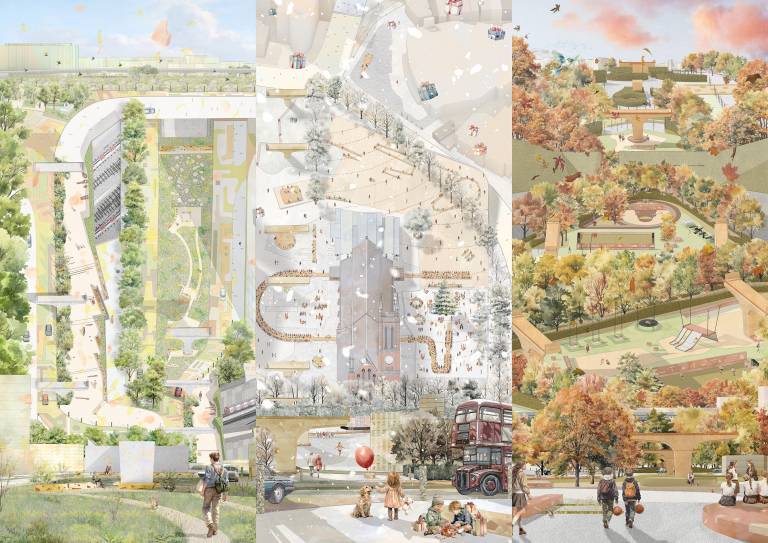
Cannon Ivers and Alexandru Malaescu
The evolutionary biologist E.O. Wilson, in an effort to combat the 6th extinction and the rapid loss of biodiversity, devised a strategy to safeguard half of Earth as wildlands. According to Wilson, “The Half-Earth project is a call to protect half the land and sea in order to manage sufficient habitat to reverse the species extinction crisis and ensure the long-term health of our planet.” (1)
The question then arises, what role can cities play in this effort and what positive impacts would they have on urban streets and spaces if the urban biosphere was seen as a critical aspect of a functioning city? What would a half living-city or half-living site look like and how it would perform?
Currently 55% of the world’s population lives in urban areas and this figure could hit 70% by 2050. As urban population increases, the design of streets, squares, parks and gardens becomes paramount to the quality of life for humans and the more-than-humans with whom we share the biosphere. As Richard Weller states: “If we are to have any hope of broaching the sixth extinction, then design must interconnect the scenic, the systemic, and the social.”
Image: Han-Tse Lee, The Room Under, DS2 2023.
- Studio 3
- Unruly Operations, Transboundary Landscapes
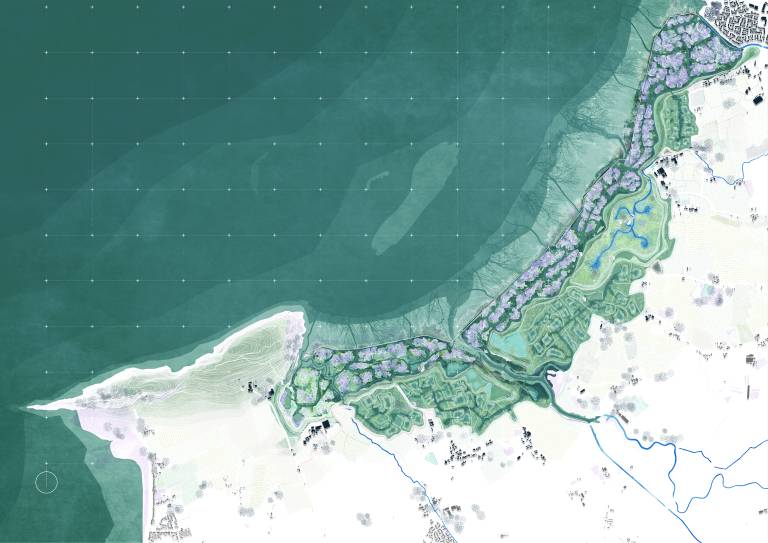
Alberto Campagnoli and Richard Beckett
This year studio 3 will continue their investigation into contemporary human - nature relationships and their affordances for the landscape, exploring the ecological dimension of life in connection with and its impact on nature. Specifically, they will explore the extent of these agencies through the concept of borders.
Working at multiple scales, the studio will focus on transfrontier sites, both in London and in Karelia, Finland, exploring how adjacent places with similar natural and cultural substrates can evolve into markedly different landscapes as a result of borders. Borders in this sense might be physical, political or ideological, they may be fixed or constantly changing, they might include current realities or explore speculative futures. The research from Studio 3 will explore the differences and similarities that are shaped by divergent cultural, socio-political, economic positions and their resulting landscape strategies.
Image: Valentina Caro Beveridge, Rewilding Coastal Landscapes - Saltmarsh Habitats as a Flood Mitigation Probiotic Agent, DS3 2023. - Studio 4
- Uncertain Sitopias
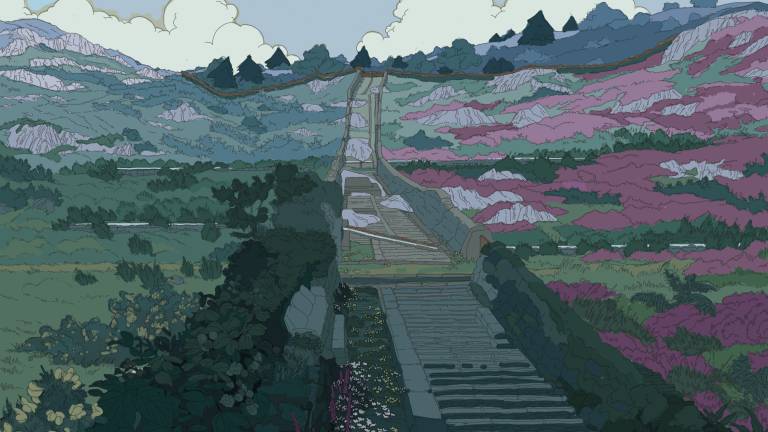
Katya Larina and Doug Miller
“Eating is an inherently political act, as well as an ecological and ethical one; there is no such thing as amoral food, any more than there is a free lunch.” - Sitopia, Caroline Steel, The Journal of Landscape Institute, 2021 Issue 1.This year Studio 4 will set out to explore Sitopias, the 12000 year old experiment of feeding the earth, and question how landscapes can adapt to survive.
The issue of food and the landscapes that fuel humanity encompass a wide array of factors. A huge variety of ecologies, politics, economics, culture, values, and identities are wrapped up in these landscapes of consumption, but the concept of Sitopia can be seen from just two simple sides. Firstly, that the landscapes we use to feed ourselves have imperilled our long-term survival on earth, and secondly the potential for sustainable and inventive solutions to foodscapes is an exciting and essential task to undertake.
Foodscapes of huge cultural and ecological value exist. The breathtaking grazing fields of the Lake District, the vineyard-covered slopes of northern Italy, or the centuries-old fishing villages found along the Mediterranean coast. These landscapes and their operation show how studying the landscape of food can reveal the unknown and the beautiful and perhaps suggest starting points for how to negotiate our way through a complex future.
Image: Biying Wang, Farming Futures of the Lake District, DS4 2023
- Studio 5
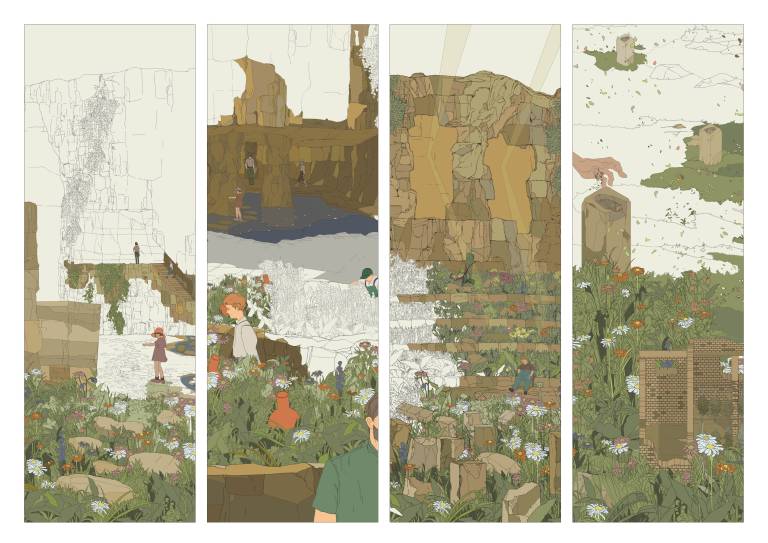
Wild Isles - Archipelagos in Flux
Laurence Blackwell Thale and Pete Davies
This year Studio 5 are exploring the diverse ecologies, challenging futures and exciting potential of island landscapes within the British Isles. Islands are test beds, proving ground and sites for experimentation. They are places that people imagine, dream about, and are fascinated by. For landscape architects, they are unusual territory, as they allow us to understand them in totality. The miniature scale suggests a level of control not possible on the mainland where invisible borders segregate and delineate. From the Scilly Isles to the wider UK archipelago and into Europe, island residents are calling for change. For too long they have experienced gross underfunding, monopolised infrastructure and unsustainably sized development models.
Studio 5 will be tackling these issues head-on, identifying moments where strategic landscape intervention can foster community resilience, suggest potential future systems and respond to complex socio-geographical issues through sensitive and context driven design.
Image: Yuelin Liu, 'Winspit's Nomadic Nursery', DS5 2023.
- Studio 7
- In the ‘Foreseeable Future’, Nature Reassembles
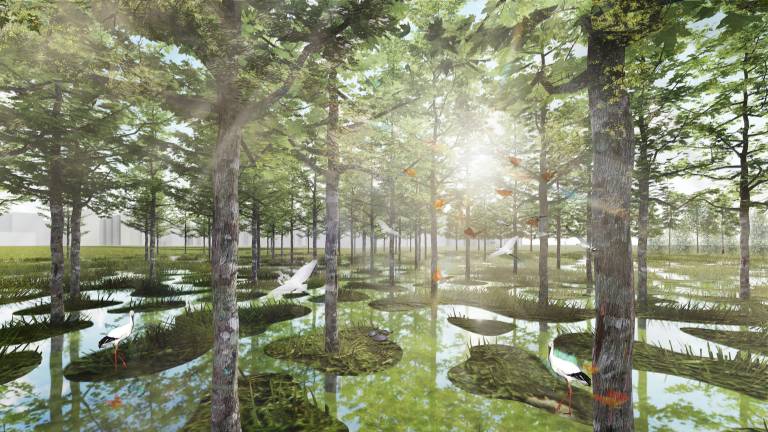
Günther Galligioni and Christina Leigh Geros
Recently, Sadiq Kahn, the mayor of London, attended a climate summit in New York where governments have gathered to discuss how best to deal with rising, searing temperatures. Kahn expressed serious concerns about London’s prospects of regularly enduring multiple days of 45C temperatures in the 'foreseeable future', with the ultimate takeaway that change must take place now. Several cities around the world shared similar growing concerns and have appointed Chief Heat Officers (all female) to rethink how cities deal with levels of heat previously unimagined. One measure adopted has been the increase of shade trees in public spaces, but is this all that can be done with the city’s greenspaces?
Outside of the urban context, increasing temperatures lead to lengthy periods of hot, dry weather that allow for the accumulation of fire-fuel and the conditions for rapid fire-spread across grasslands and forests. Wildfires are not a new phenomenon - albeit an increasingly catastrophic and endemic condition - to landscapes across southern Europe, but they are an emergent risk in the UK that we are hardly ready for. How can landscape architecture contribute to new ecologies, management and co-management strategies, and aesthetic values that can prepare and reshape the British landscape without erasing its deep traditions and histories?
Image: Yanli Ma, The Vanishing Farm, DS7 2023.
- Studio 8
- Locally Remote
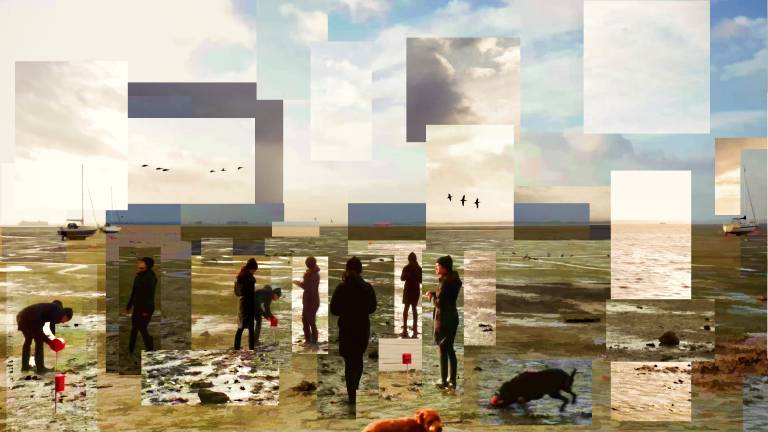
Tom Budd and Lynn Poon
It is taken for granted that time moves forward in a linear fashion, minutes tick by as populations rise and cities develop and grow at an ever-increasing rate. This fast linear time seems to bring about a disconnect and detachment between people, communities and the natural environment within which they inhabit. Shifting the view to the more isolated, rural and remote communities across the world reveals a different connection between people and place. With increased isolation, a stronger bond emerges between inhabitants and their surrounding environment and landscape. This connection forms a more cyclical relationship with time, rooted in tradition, rituals and seasonality that has enabled communities to withstand and thrive within harsh environmental conditions for decades.
Through this lens, Studio 8 will be investigating what can be learnt from remoteness and isolation. In places with a strong connection to their natural landscapes, what benefits can a sense of slow, circular time provide, and how can a reconnection with this cyclical way of thinking provide new insights for our future?
Image: Ana Patricia Garrido Chávez, Landscape Choreographies, DS8 2023.
Research
Bartlett Landscape and Environmental Research: Remote Ecological Monitoring
Students on the Landscape Architecture programmes can learn from and engage with ongoing Landscape Tutor-led research. Currently underway is long-term research monitoring, interpreting and responding to changes in landscape over time.
The Bartlett Landscape and Environmental Research: Remote Ecological Monitoring project looks at how climate change, management practices and ecological development impact the performance and various functions of the UK’s woodlands and rural landscapes — including their ecological, social, cultural and economic roles. In close partnership with Flimwell Park, this research explores the past and future of the UK’s woodlands through a combination of remote data collection, innovative monitoring and learning from species, materials and people on the ground.
This research has been supported by funding from Research England’s Research Capital Investment Fund.
 Close
Close


